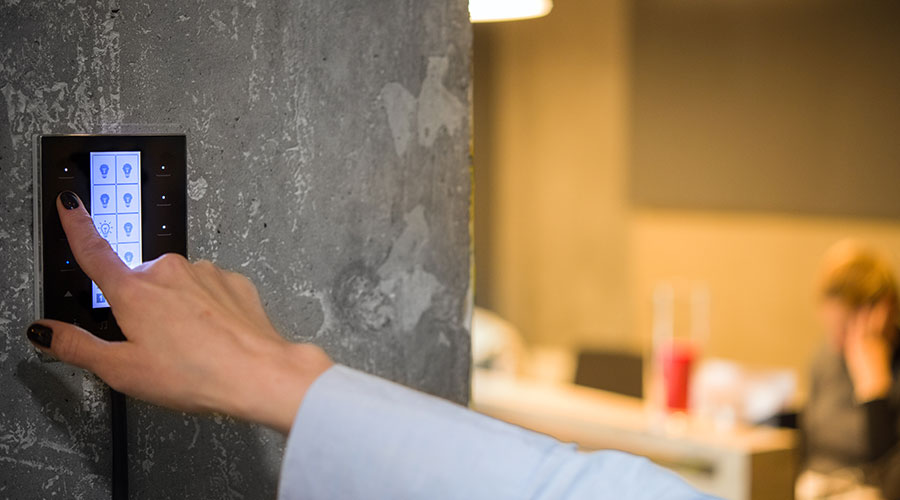Lighting Controls Upgrades Done Right Mean Energy, Cost Savings
First of a two-part article explaining best practices for lighting controls upgrades, and their many benefits.
Cutting operating costs for lighting typically involves installing energy-efficient lamps or fixtures, reducing burn hours, and maybe dropping light levels (e.g., dimming, task tuning). The first option includes changing to 28-watt T8 fluorescent or LED lamps, while the last two involve lighting controls.
Facility managers are comfortable selecting lamps, but may be less so when confronted by the ever-widening choices for controls. Many are finding that upgrading lighting has become more complex. It takes homework, and sometimes expert guidance, to make good choices.
The simplest lighting control has always been the wall switch. But switches have grown up. Specialized units (working with step-dimming ballasts or relays) now allow bi-level lighting, as required by some energy codes. Such step dimming may offer a good payback where lower light levels are acceptable for some tasks. Wall switches have also become wireless, controlling banks of lights without the cost of power or signal wiring. The EnOcean wireless system uses the energy from the pressure of a finger on a switch to send radio signals to hidden receivers and relays. This method, adopted by many controls manufacturers, also allows easy alteration of lighting zones.
Occupancy sensors have been common for decades where power pricing is high. But the cost to install them has dropped due to long-life batteries that eliminate the need to install power wiring, and wireless communications that allow sensors to be easily located as needed. The latter has been a boon in open office areas where partitions and people move as a business grows.
The cost of daylight harvesting has been hard to justify due to the cost of dimming ballasts, but lower prices for sensors and wiring have helped a bit. Some energy efficiency incentives focusing on kWh reductions have also helped buy down that cost.
Demand response programs that pay for occasional load reductions have expanded, making step dimming ballasts a potentially lucrative option. Significantly cheaper than continuously dimming ballasts, such units may be initiated manually or else automatically by a signal from a utility. Light level gradually drops (over about a minute) by about 30 percent, saving power, while not distracting occupants with the temporary change.
Where work tasks vary in their need for light, dimming (either continuous or in steps) may be an easy way to match light levels to them. When a space that was once a library becomes a cafeteria, or a room previously filled with drafting tables is now full of computer monitors, lamps may be significantly dimmed without touching a fixture.
Newer options
Even those options look oh-so-last-decade now that it’s possible to tune not only light intensity but also light color. LED lighting with that ability offers the potential for changing correlated color temperature, measured on the Kelvin temperature scale: Higher K means more blue in the color mix, while lower K means more yellow-orange. Rather than last century’s limited fluorescent choices of “warm white” (2700 K) and “cool white” (4100 K), it’s now possible to produce light with temperatures between, above, or below them.
Why do so? Research has found that adjusting light color to mimic how natural light varies during the day can subtly alter human behavior: More blue may enhance alertness while more yellow-orange may foster relaxation. Called “circadian stimulus,” this process is being deployed or considered in sites as varied as nursing homes and schools.
Yet another new lighting frontier has appeared. Imagine walking down the aisle of a store and receiving on your smart phone an electronic coupon for a product that just went on sale. That signal then directs and tracks you, with a map, to the location of the product. Called “visual light communication,” this process uses high-frequency flicker (well above human detection) from LED light fixtures to send information to your phone, which may respond with signals to receivers in the ceiling or fixtures using one of several other methods (e.g., Bluetooth, WiFi, cellular). Lighting becomes a sales enhancement tool, a product tracking and inventory system, and a way to communicate safety or security information.
Some of these capabilities are being merged into networked lighting systems and controls running on a variety of wireless communications protocols, e.g., Zigbee, Z-Wave, Bluetooth. But don’t give up on wires yet. As the Internet of Things (IoT) movement expands, near-future fixtures may be connected via the web and programmed from a central building management system. Doing so may allow easy alteration of light levels and zones while collecting data on fixture energy, tipping facility managers off to where maintenance may be needed.
Stack of new challenges
While advances in communications and controls offer ways to save money and energy, three overlapping levels of complexity have given facility managers pause:
• Difficulty in evaluating competing technologies due to a lack of communication standards, and also due to lack of integration with existing or planned lamps, networked lighting controls, or other systems (e.g., security, information technology).
• Shifting economics that are the result of rising lighting energy efficiency, fluctuating rebate options, and changes to utility rate structures.
• Tightening energy codes that may require controls in new construction and renovation, regardless of the cost or dollar savings they may provide.
Where does a facility manager start? First, sort out the technologies.
In the old days (less than 10 years ago), technologies for controlling fluorescent lamps were relatively simple. Integrating the options discussed above with existing or planned construction may now, however, require a more specialized level of knowledge. The entry of LED retrofit options (plug-and-play lamps, LED power supplies) adds another wrinkle.
Of the dozens of tubular LED (TLED) options identified by the DOE Lighting Facts program, many claim to be dimmable. Experience shows, however, that some do so acceptably down to about 20 percent of maximum light output, and then flicker or shut off just below it, or pop-on / pop-off in between. Others dim in a non-linear fashion, i.e., little impact on light until a slide dimmer is halfway down, followed by a big drop, and then no change to the end of the slide. Some work with analog, but not digital, dimmers (or vice versa). A few will list which dimmers work with their units, while others indicate that dimming may void the lamp warranty.
To address such issues, it pays to think through potential control needs and strategies before investing heavily in TLEDs or LED retrofit kits. While they may come at low prices, a facility manager may be getting only a little of the company’s money’s worth while significantly limiting future control opportunities. Before investing in equipment designed to last 20+ years, mockups are essential to verify compatibility between light sources and controls.
Related Topics:













